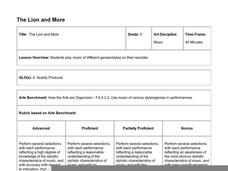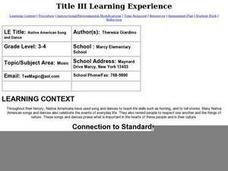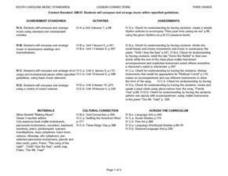Hawaiʻi State Department of Education
The Lion and More
Melody, rhythm, tempo, and dynamics; get out those recorders it's time to play music! Your class will work on playing two lion-themed pieces that exemplify two different styles, folk and waltz. They'll discuss the elements of music and...
San Francisco Symphony
Aaron Copland: Billy the Kid
Your class can think about the American Old West as they listen for dynamics, articulation, rhythm, and tempo in the Aaron Copland song, "Billy The Kid." They'll explore how Copland uses music to create an image of life for an outlaw in...
Hawaiʻi State Department of Education
Spontaneous Inventions
Reading out loud can be a real thrill for some, and a real issue for others. Teach your class that reading with inflection and fluency can be as easy as singing a song. They'll first analyze two Bobby McFerrin songs for intonation,...
Hawaiʻi State Department of Education
Suki's Kimono
In the story Suki's Kimono drums are used to show mood. Learners discuss mood in the story after they practice playing a simple 4/4 rhythm on their drums. Each group plays the rhythm using a different tempo. They listen to each...
Curated OER
Exploring and Using Shapes to Make a Dance
Second graders use their bodies to create various shapes to make a dance when given various music and beats. In this shapes and dance lesson plan, 2nd graders create lines, curves, twists, and angles with their bodies.
San Francisco Symphony
Quilt Making and Copland's Rodeo
Kids make quilts as they learn about pioneer life and the concept of tempo. The Aaron Copland piece, Rodeo is used to convey rhythm and tempo in music. As the children discuss tempo and rhythm, they also discuss what life was like for...
Curated OER
Using Rhythm to Teach Patterns and Directions
Introduce young learners to line dancing. Here are some simple movement patterns to teach them. First teach, repeat, and repeat again without music. Then when they have a pretty good grasp of the movement patterns, add music and practice...
Curated OER
3-5: Rhythm Beginnings
Learners explore tempo. In this rhythm beginnings lesson, students differentiate between steady and unsteady beats. Learners clap a variety of tempo and then move to the tempo of a song.
Curated OER
Tony Bennett: With Special Guests The Backstreet Boys - Lesson 2
Students clap four-beat rhythm patterns containing whole, half, dotted half, quarter, and eighth notes and rests in a given tempo. They clap the tempo as their teacher holds up flash cards.
Curated OER
Native American Song and Dance
Students examine the importance of the drum and drumming in the cultural context of the Native American. Musical insturments and native dance is employed to support the focus of the lesson.
Curated OER
Compose Your Memory
Students notate a short musical composition using the notation software Sibelius. This composition is based on a the student's favorite childhood memory. Based on their emotions felt at this time, they incorporate tempo, range, and...
Curated OER
DO YOU REMEMBER?
Pupils explore where a melody and melody fragments enter different voice parts, and adjusts dynamically to enable the listener to perceive these events. Each student uses a rubric to make critical evaluations of the performances.
Curated OER
The History of Rock and Roll: Parts 1, 6, 8, and 10 Roots of Rock & Roll
Students examine the musical influences on the emergence of Rock and Roll.
Curated OER
Rhythmic Movement Skills
Students practice using their physical skills while performing physical activities. In this physical education lesson, students participate in musical orchestrated dances with their classmates. Students utilize a jump rope...
Curated OER
Found Poem - Found Song
In this Louisiana music worksheet, students learn that a found poem is made using words and phrases from some things they have read and, then write a found poem following the steps listed on the worksheet.
Curated OER
Music: Rhythm Patterns
Fourth graders describe and play various tempos as part of this beginning instrumental instructional activity. They recite tongue twisters to a medium, largo, and allegro tempos. As an extension, 4th graders use software as an...
Curated OER
Lesson Connections
Third graders sing alone, with others and practice a varied repertoire of music. They have to sing using appropriate timbre, diction, and pesture, all while maintaining a steady tempo. Singly expressively, with appropriate dynamics,...
Curated OER
VH1 200 Greatest Pop Culture Icons Lesson 2
Students compare two versions of song done as an original and as a cover. They attempt to arrange a pop song to show a different musical style.
Curated OER
Chinese Percussion Music
Students investigate Chinese percussion instruments and ensemble performances. They play compositions with Chinese percussion instruments such as small gongs, large gongs and drums.
Curated OER
Watch Your Conductor Like a Hawk
Students focus their eyes on the conductor in music class. The teacher uses a music sheet to isolate the musical elements of tempo, balance, and blend.
Curated OER
Tap Your Feet
Students listen to, analyze, and describe music. They experience performing on instruments, alone and with others, a varied repertoire of music.
Curated OER
Analyzing Two Dances and Making a Dance Map: The Nutcracker
Students discuss dance elements and create a dance map. They choose a dance theme and incorporate movement into their dance maps and choreography. They also experiment with different types of music.
Curated OER
Rhythm In Motion
Sixth graders work independently and with a partner to demonstrate proficiency of steady beat, meter and basic note values while creating written rhythmic patterns for class performance. State and National Standards are addressed.
Curated OER
Street Safety
Students explore fire safety rules through a variety of teacher-led activities. In this safety lesson, students choose appropriate felt board pieces as they listen to My Car by Byron Barton. Seat belt and car seat safety, as well as...























